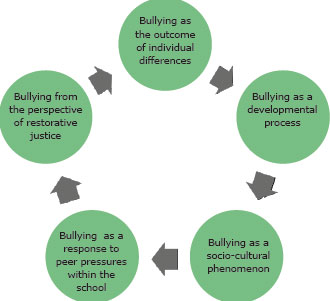What Causes School Bullying?
Bullying behaviour is a complex issue and research in the area does not identify the supremacy of any one cause of bullying. Below is a summary overview of key factors that are considered to contribute in various ways, to the likelihood of bullying behaviours. The information below is not a complete list of all factors. They do represent major categories of focus with examples of predominant factors of influence within each.
Environmental Factors
Physical violence in the media may contribute to bullying (Berkowitz, 1984; Smith and Donnerstein, 1998). This is a difficult area to generalise about as some students can watch a lot of violence in the media and not be affected while other students can display higher levels of aggression from watching a lot of violence in the media.
Social factors
Dysfunctional families – Children who bully are 3 times more likely to have family or parental problems (Stephenson and Smith, 1989). Children who have positive relationships with their parents are less likely to bully (Rigby, 1993; Bowers et al.; 1992).
Bystander Factors
The presence of bystanders can contribute to the bullying (Olweus, 2001). Bystanders can be passive which condones the bullying incident or can prevent others from intervening (Salmivalli, 2001).
Cairns and Cairns (1994) identified the influence of peer groups. While individuals more than groups, exhibit bullying behaviour (Rigby and Slee, 1999), around 85% of bullying incidents happen within peer groups (Atlas and Pepler, 1997). A study on bullying incidents in playgrounds found although bystanders were present in 88% of bullying incidents, they only intervened in 19% of cases (Hawkins, Pepler and Craig, 2001).
Individual factors
The bully’s own predisposition. Children who bullied have been reported as being low in empathy and therefore not being sensitive to the plight of others (Enderesen and Olweus, 2001; Menesini et al.; 1997). Students themselves gave the following reasons for bullying (Rigby, 2008):
- The other child annoyed them
- To get even
- For fun
- Others were doing it too
- Because they were wimps
- To show how tough I am
- To get things or money
Theoretical Explanations for Bullying Behaviour
Rigby (2004) puts forth a number of different theoretical explanations as to the potential cause of the bullying behaviour. A summary of these ideas are presented below in a diagram and accompanied explanation of each factor presented in the diagram.
Bullying as the outcome of individual differences
This approach suggests bullying results from the differing level of personal power between each student. These differences are either physically or psychologically based.
- Bullies tend to be physically stronger than the average student and from a personality perspective, tend to be more aggressive, manipulative and low in empathy (Olweus, 1993).
- Victims tend to be physically weaker, introverted with low self esteem (Slee and Rigby, 1993).
School programs based on this perspective tend to focus on changing behaviour of bullies through counselling and/or discipline as well as looking at changing behaviour of victims through social skills and assertiveness training.
Bullying as a developmental process
This approach is based on the belief that there is a natural instinct to dominate, in terms of social dominance, to ensure survival of the species. Initially children engage in more physically direct means of bullying but as they progress developmentally, they adopt less socially offensive means of bullying by replacing them with more indirect means (Rigby, 1997).
This perspective leads schools to adopt programs that positively foster the developmental growth of students and challenges schools to address the subtle changes in bullying as students mature.
Bullying as a socio-cultural phenomenon
This approach takes a broader societal perspective when identifying the cause of bullying behaviour. Bullying is seen as a consequence of the power differential between various social groups in our society based on gender, race, social class, etc.
- Bullying is more often initiated by boys than girls (Olweus, 1993; Smith and Sharp, 1994).
- Boys are more likely to bully girls than vice versa (Rigby, 1997).
School programs adopting this perspective develop programs that address prejudice and discrimination and attempt to increase the cultural sensitivity by introducing a collective and cooperative approach. The Australian web site www.bullyingnoway.com.au operates from this perspective.
Bullying as a response to peer pressures within the school
This perspective sees bullying as a group phenomena. Groups are not necessarily tied to race, gender, etc. but exist through a common interest or purpose. Within a school environment, the peer group will often bully another group or individual for a reason (real or imagined) or simply just to have fun.
- Bullies have admitted to acting as part of a group for half of the bullying incidents they have been involved in (Rigby, 2002).
- Bullying by individuals is more commonly conducted with the support of a group (Pepler and Craig, 1995, 2007).
School programs working from this perspective focus on groups attempting to utilise the peer pressure of the group to positively influence responsible individual action. The Method of Shared Concern (a staff training resource for bullying) works from this perspective.
Bullying from the perspective of restorative justice
This approach takes an individualistic view of the bully and sees bullying behaviour as a result of the specific and unique psychological and emotional characteristics of the bully. It views bullies as not being able to self regulate with feelings of shame.
Bullies are considered not to have pride in their school nor integrate well into their community (Morrison, 2002). Programs based on this approach believe the school community and significant others should support the bullies as they are provided with opportunity to expose their wrongdoing in a caring environment not a punitive environment. The primary aim is to restore positive relationships among the bully and victim and the whole community.



full and good answers
thanks so much your answers are so real and very correct